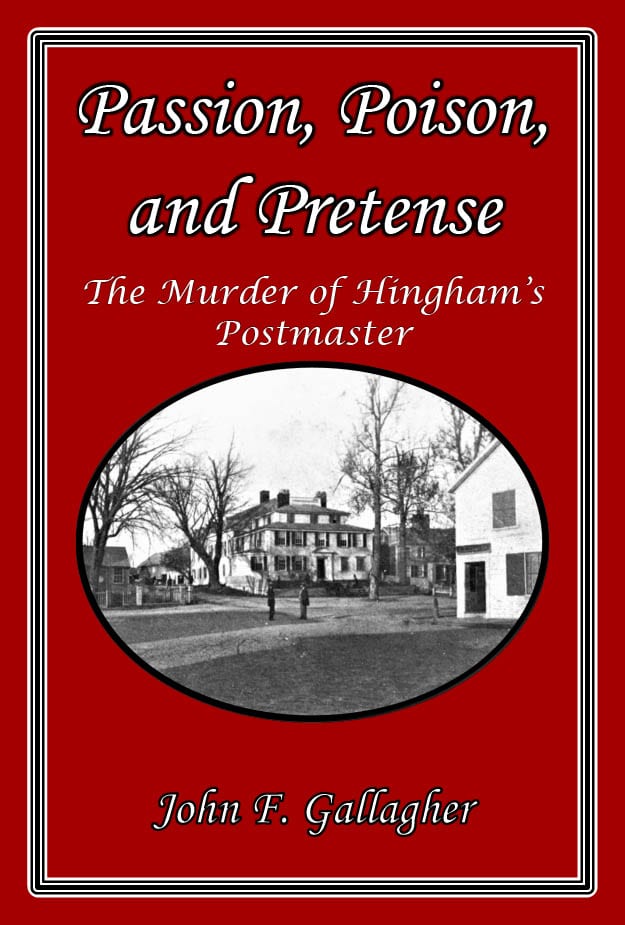Monday, October 26, 2020 by Carol Britton Meyer
For those who love a good mystery, John Gallagher's compelling "Passion, Poison, and Pretense: The Murder of Hingham's Postmaster" – set in the 1850s and based on a true crime – won't disappoint.
While the novel is rooted in history, some dialogue and scenes are fictional and based on the author's research.
A recent book-signing at Hingham Historical Society – which was a great source of information and photographs for this historical novel – was a huge success: "It was a perfect day, with so many people out and about during the Hingham Arts Walk," Gallagher said. "It was terrific. I sold dozens of books!" This historical novel is so popular that Gallagher needed, much to his pleasure, to order more.
Without giving the outcome away, Gallagher shared some details of the story behind the novel: "Hingham Postmaster Hosea J. Gardner left his office at Main and South Streets late on a cold evening in February 1857. As he proceeded toward his home a short distance away on North Street, he slipped on a patch of ice and fell heavily on his right side. Tailor John Todd and Sea Captain James Soule heard his cries for help and rushed to his assistance.
"The two men guided him home and summoned a physician. Dr. Ezra Stephenson examined Hosea and found no broken bones; he recommended bed rest, prescribed some medicine to help with the pain and assured Hosea he’d be back on his feet in a few days. When the doctor returned several days later to check on the progress of his patient, he found Hosea in distress.
"Stephenson could not understand the reasons for Hosea’s deteriorating condition and did his best to treat him. Three days later, Hosea was dead. Unable to account for the cause of his patient’s demise, the doctor turned to town authorities. An inquest was convened and an autopsy performed. Hosea’s organs were found to contain a fatal dose of arsenic. He had been murdered."
Suspicion almost immediately fell upon Hosea’s wife, Abigail, followed by an autopsy and inquest leading to the arrest of Abigail and her indictment for murder.
Passion for writing true-crime novels
Writing a series of historical novels about century-old murders on the South Shore -- "Passion, Poison, and Pretense" is the fourth -- was a big jump for Gallagher, a retired Boston police officer and chief of detectives with an interest in history and genealogy and a background in criminal investigation.
That said, it is precisely those interests and his 30 years of experience with the Boston Police Department that evolved into a passion for writing true-crime novels.
Gallagher also wrote "A History of Homicide in Hanover: Murder on Broadway," set in his hometown; "Arsenic in Assinippi: The Trial of Jennie May Eaton for the Murder of Her Husband, Rear Admiral Joseph Eaton," set in Norwell; and "A Monument to Her Grief: The Sturtevant Murders of Halifax, Massachusetts."
Writing historical novels "takes a lot of time and discipline, research and legwork," Gallagher said, and he enjoys every minute of it.
Extensive research is required – between 2-1/2 to 3 years for each book including the writing part – to be sure all the facts are correctly stated. "Thank goodness local reporters covered the trial," he said, because newspaper coverage played an important part in writing the postmaster novel.
Hingham Historical Society role
Gallagher found a wealth of information at the Hingham Historical Society, spending time in the archives and talking at length with HHS Collections Manager and Registrar Michael Achille and HHS Archivist Bob Malme. "They were both terrific, especially with assisting me in finding information and historic photographs for the book," Gallagher said. "They helped me get the flavor of what pre-Civil War life was like, which rounded out the book tremendously."
The novels of well-known Hingham author, narrator, popular historian, and lecturer David McCullough are among his favorites. "He's been an inspiration to me," Gallagher said.
"Passion, Poison, and Pretense" tells the "concise, engaging, true story of one of the earliest and most well-documented murder cases in Massachusetts, right here in our backyard," wrote Achille in a review of the book. "Filled with wonderful detail, John’s book touches not only on this fascinating piece of Hingham history but also how it fits into the broader history of the development of the judicial system in the fledgling United States. I couldn’t put it down!"
And to think, Achille said, "the broad-sweeping changes to how our criminal justice system is organized nationwide had their roots here in Hingham. I continually find in my work that all roads led back to here in some way. It's exciting."
The list of characters is seven pages long, including the victim, the accused, their family and friends – including a silk and tassel maker and a house painter and glazier; inquest jury members, including Hingham grocer David Fearing and Trader Martin Fearing, shoemakers Peter and Joseph Sprague, and other Hingham residents; defense attorney Henry Edson Hersey; the judges and the prosecution team; defense attorneys; members of the first and second trial juries; physicians; religious figures; undertakers; local police including Hingham constable and house wright (builder of wooden houses) Gridley F. Hersey, who arrested Abigail; and witnesses who included a Hingham tailor, druggist, and a weight and balance maker.
"The book is written from the perspective of the characters, who were real people, including the judges," Achille said, "and is based on actual trial notes and transcriptions."
Maps help bring story to life
Two maps, courtesy of the Historical Society, marked with the locations of many of the scenes in the book allow the reader to get a real feel for what life was like in Hingham in the 1850s "and helps bring the story to life," Gallagher said.
The reader can actually walk to these places and "experience" where certain evidence was found and where a particular character in the book lived; for instance, the Gardners lived on North Street where the post office once stood. Their house shared the lot with the former Union Hotel.
The Hingham postmaster murder case came to Gallagher's attention when he was reviewing an old annual attorney general report detailing capital cases that had been prosecuted in Plymouth County back to the 1840s: "A woman being prosecuted for murder was rare at that time," he said. "I looked further into it and thought it was an interesting story. I went all out to get to the bottom of everything that happened."
Gallagher and his wife, Jeanne, live in Hanover, where they enjoy visits from their six grandchildren.
Copies of Gallagher's book are on sale at the Hingham Heritage Museum Shop and Acquire Good in downtown Hingham, at Aisling Gallery on Lincoln Street, and through the author's website and Amazon.
For more information visit gallagherbook.com.




Fantastic report, John!!! Well deserved..this book was a treasure for so many locals. I couldn’t put it down. You did a great job putting it into a story form. Thanks for a good job done!! Proud of you!!!